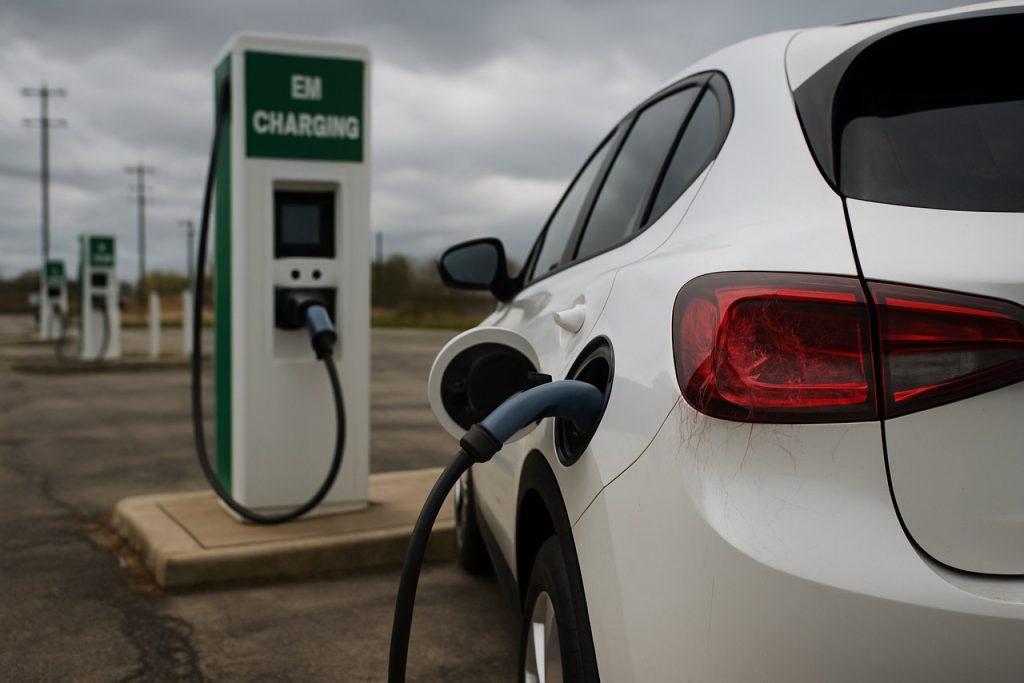
- EV adoption is accelerating in the U.S., but public charging infrastructure remains insufficient, especially in rural and lower-income areas.
- Government funding for new EV charging stations faces budget cuts and regulatory delays, stalling nationwide expansion plans.
- Charging “deserts” persist even in leading states, making long-distance EV travel challenging due to unreliable or insufficient charging points.
- Private companies like Tesla and Electrify America are expanding charging networks, but costs, permitting hurdles, and equity issues slow progress.
- The future of electric mobility hinges on bridging infrastructure gaps with innovative partnerships, policy support, and equitable access to chargers.
Streetlights flicker on across America, illuminating more electric vehicles gliding silently than ever before. Yet, while automakers race toward a battery-powered future, EV drivers in many regions are hitting an inconvenient truth: public charging infrastructure is not keeping up.
Empty Promises, Crowded Plazas
Ambitious pledges to blanket the nation with high-speed chargers stall as government funding wavers and red tape snarls progress. This year, thousands of federal funds dedicated to new charging stations face deep cuts, leaving communities in limbo. The U.S. Department of Transportation once set a goal of half a million public chargers by 2030. Today, they’ve barely cracked 170,000—most located in bustling cities, leaving rural highways a barren landscape for EVs.
Growth Surges, Chargers Lag
America’s appetite for electric vehicles surges. Sales of EVs jumped 46% last year, according to the Environmental Protection Agency. In states like California, every fourth new car hums with electrons instead of gasoline. However, even the sunniest states struggle with “charging deserts”—vast pockets outside urban corridors where plugging in requires a wild detour or hours of waiting.
For Many, The Tipping Point Nears
Imagine planning a road trip only to find the only charger for 100 miles is out of order—again. For EV drivers and would-be buyers, the lack of reliable charging threatens to stall the momentum. Even popular fast-charging networks buckle under pressure. With adoption outpacing infrastructure upgrades, queues snake from chargers at peak times and breakdowns can mean stranded motorists.
Private Sector Steps In, But Can’t Bridge the Gap
Some companies invest furiously. Tesla expands its Supercharger empire, now opening up stations to non-Tesla cars in an unprecedented move. Electrify America and ChargePoint sprint to install new ports. But expensive hardware, tricky permitting processes, and demands from local utilities slow deployments.
Moreover, charging equity remains an unresolved issue. Lower-income neighborhoods and rural areas see far fewer charging stations, deepening a digital—and electrical—divide that leaves certain drivers behind.
The Key Question: Where Do We Plug In Next?
As Congress debates future infrastructure budgets, the clock ticks for car owners banking on a charging revolution. Proposed legislation aims to streamline permits and unlock stalled funds. But until these political and technological roadblocks clear, America’s electric mobility faces a palpable limit.
The Takeaway: The race toward an electric future can only go as fast as the nation’s charging network. Bold targets means little if drivers reach a dead end—and today, the map is filled with blank spaces. Building a robust, accessible network will require renewed commitment, creative public-private partnerships, and a shared recognition: the road to decarbonization is only as strong as the power flowing through its veins.
Shocking Reality: Why America’s EV Revolution Is Running Out of Juice—And What Needs to Change Now
# America’s Charging Crisis: Untold Facts, Life Hacks, and the Real Road Ahead for Electric Vehicle Owners
The electric vehicle (EV) surge is undeniable; more Americans than ever are opting for cleaner, quieter rides. Yet as the number of EVs skyrockets, experts are raising alarms: the network of public EV charging stations is stretched thin, and the gap is only getting wider. Here, we dig deeper—providing additional insights, statistics, and real-world perspectives every EV driver, policymaker, and curious commuter needs to know.
Fast Facts EV Drivers Need to Know
– Growth Outpaces Infrastructure: As of 2024, the U.S. has over 3.5 million EVs on the road (Atlas Public Policy, 2024), but less than 180,000 public charging ports (excluding home chargers), according to the U.S. Department of Energy Alternative Fuels Data Center.
– Charger Types Matter: DC fast chargers (Level 3) can add 60–80 miles of range in 20 minutes, but constitute only about 15% of all public chargers. The majority are slower Level 2 chargers, which can take hours to recharge a battery fully.
– Regional Disparities: States like California, New York, and Florida boast the majority of public chargers; meanwhile, large swathes of the Midwest and South remain “charging deserts” (J.D. Power, 2023).
– Home Charging Isn’t An Option for Everyone: Approximately 30% of Americans live in multi-unit dwellings—apartments or condos—with limited access to home charging, making public infrastructure critical (National Multifamily Housing Council, 2023).
Pressing Reader Questions—Answered
1. Why is Infrastructure Lagging Behind?
– Permitting Delays: Local government approvals can take months, hampering timely charger installation.
– Utility Coordination: Upgrading grid connections often requires negotiations and technical assessments, especially for high-speed DC chargers.
– Operating Costs and Vandalism: High maintenance costs, spotty reliability, and acts of vandalism or theft increase expenses, slowing network growth.
2. Are All Charging Networks Created Equal?
No. Differences in speed, payment options, and network reliability abound:
– Tesla Supercharger: Industry-leading uptime (>99%) and speed, but proprietary (now slowly opening to non-Teslas).
– Electrify America & ChargePoint: Widely dispersed, but users frequently report reliability and payment hiccups.
– Blink & EVgo: Slower expansion and inconsistent charger availability.
For reviews and up-to-date comparisons, consult Consumer Reports.
3. What About Security and Equity?
– Security: Public chargers need robust monitoring to prevent vandalism and ensure personal safety, especially at night.
– Equity: Rural, lower-income, and minority-majority communities have far fewer chargers per capita—compounding mobility challenges already faced in these areas.
4. What’s Happening with EV Charging Incentives?
Federal grants (like those from the National Electric Vehicle Infrastructure (NEVI) program) have been vital, but future funding is uncertain. Several states offer their own rebate programs; check your local Department of Transportation or U.S. Department of Transportation for details.
Actionable Life Hacks & How-To Steps for EV Owners
1. Plan Your Route:
Use apps like PlugShare, A Better Route Planner, or the official app from your chosen charging network. Always identify backup stations before a road trip.
2. Charge Off-Peak:
Charging late at night or midday (when daytime usage dips) can help avoid lines and sometimes nets off-peak rate discounts.
3. Join Loyalty Programs:
Network-specific apps sometimes offer reward points, lower rates, or reservation abilities—especially for frequent users.
4. Advocate Locally:
Petition local governments, employers, or housing associations to speed up installation. Grassroots demand can unlock funding.
Market Trends & Predictions
– Fast Charger Growth: The U.S. fast-charging market is expected to grow at a 28% compound annual rate through 2030 (Grand View Research, 2023).
– Charging as a Service: “Charging as a Service” business models—where third parties own and operate charging assets for property managers—are gaining traction for workplace and apartment installations.
– Bidirectional Charging (V2G): Newer EVs can give power back to the grid or your home, but require compatible infrastructure.
Controversies, Limitations & Pros/Cons Overview
Pros:
– Reduced emissions and lower fueling costs over time.
– Less maintenance compared to combustion engine vehicles.
– New jobs in charging infrastructure build-out.
Cons:
– Range anxiety due to charging uncertainty—especially for non-Tesla vehicles.
– Network reliability issues (J.D. Power’s 2023 Charging Experience Study found that 21% of drivers abandoned a session due to malfunction or overcrowding).
– Upfront costs for fast charger installation can top $100,000 per site, creating economic barriers (Forbes, 2024).
Real-World Use Cases & Tutorials
Example:
A Denver apartment complex recently installed 12 Level 2 chargers via a utility partnership, splitting costs with tenants who agreed to small rent increases in exchange for guaranteed parking and charging spots.
How-To for Property Managers:
1. Survey tenant demand and available electrical supply.
2. Consult with state energy offices on incentives.
3. Partner with local utilities for reduced rates or rebates.
4. Select an installer with a proven service record.
5. Ensure chargers support Open Charge Point Protocol (OCPP) for maximum compatibility.
Security, Sustainability & Compatibility Features
– Smart Chips: New chargers integrate chipsets that allow remote diagnostics and over-the-air updates.
– Payment Options: The push for universal credit/debit card payment continues, but some networks still require proprietary apps.
– Solar & Battery Integration: Pilot projects pair public chargers with on-site solar and battery storage to reduce grid strain.
Reviews, Comparisons & Expert Opinions
– In the 2023 J.D. Power Public Charging Study, Tesla Supercharger scored highest in user satisfaction, followed by ChargePoint and Electrify America.
– Experts stress that simply increasing charger numbers is not enough—maintenance, software reliability, and interoperability are equally crucial (Green Car Reports, 2024).
Quick Tips and Recommendations
– Check Charger Reviews: In PlugShare, look for “recent check-ins” before committing to a charger.
– Sign Up with Multiple Networks: This unlocks more locations and can serve as a backup if your preferred charger is full or broken.
– Lobby for Funding: Contact your state representatives about supporting bills that streamline permitting and unlock infrastructure funds.
The Road Ahead: What Needs to Happen
America’s electric vehicle success depends on a robust, reliable, and equitable charging network—one that matches consumer demand, technological innovation, and regional realities. Policymakers, private companies, and everyday drivers need to collaborate with urgency.
Want to learn more about the future of transportation? Visit the U.S. Department of Transportation for breaking news on funding, policy, and new initiatives. For environmentally-focused updates, check the Environmental Protection Agency.
KEYWORDS: EV charging crisis, electric vehicles, public charging infrastructure, fast charging, charging equity, US Department of Transportation, Electrify America, Tesla Supercharger, market trends, EV tips



